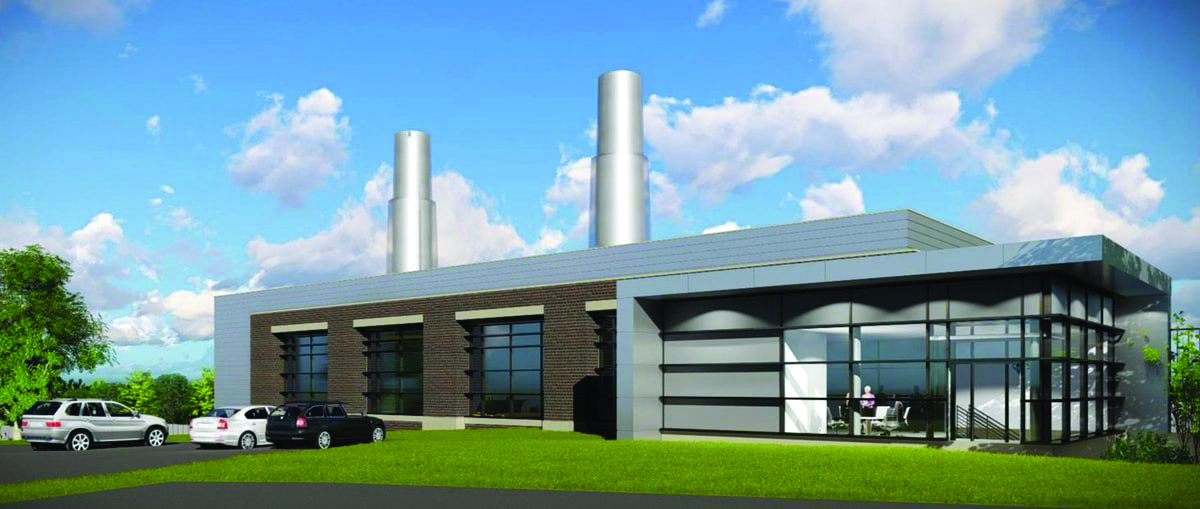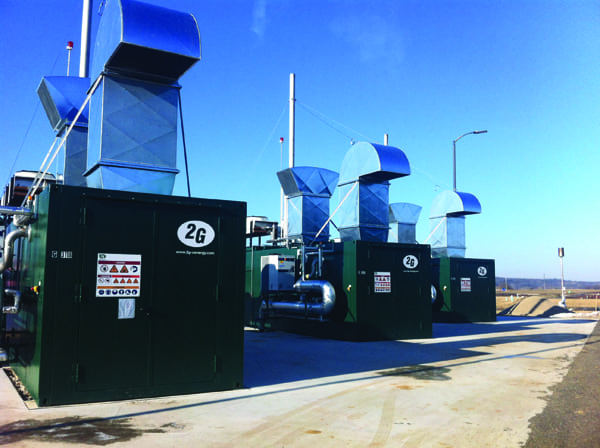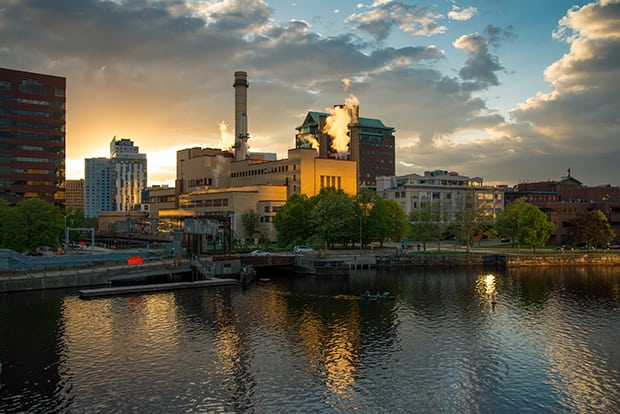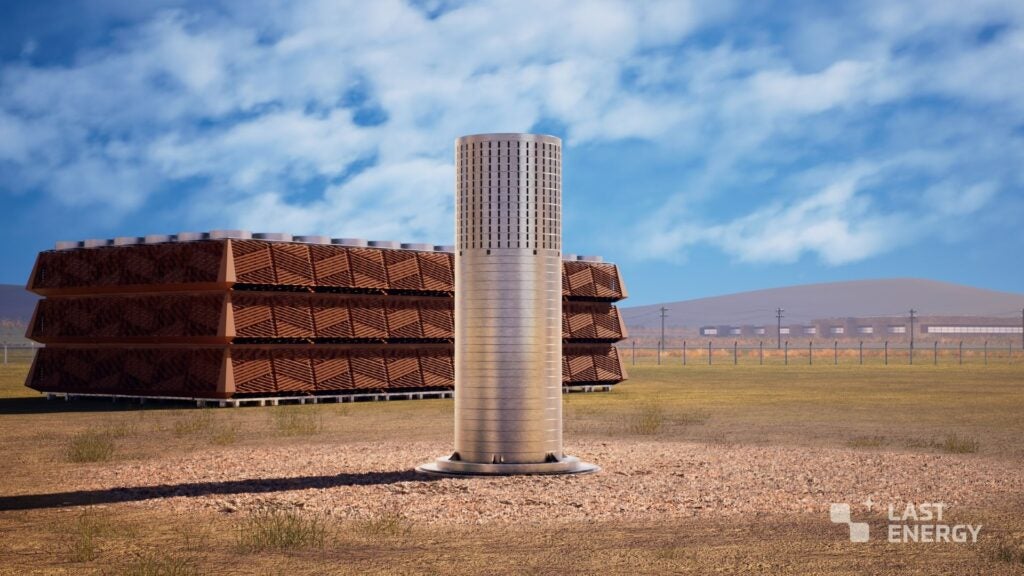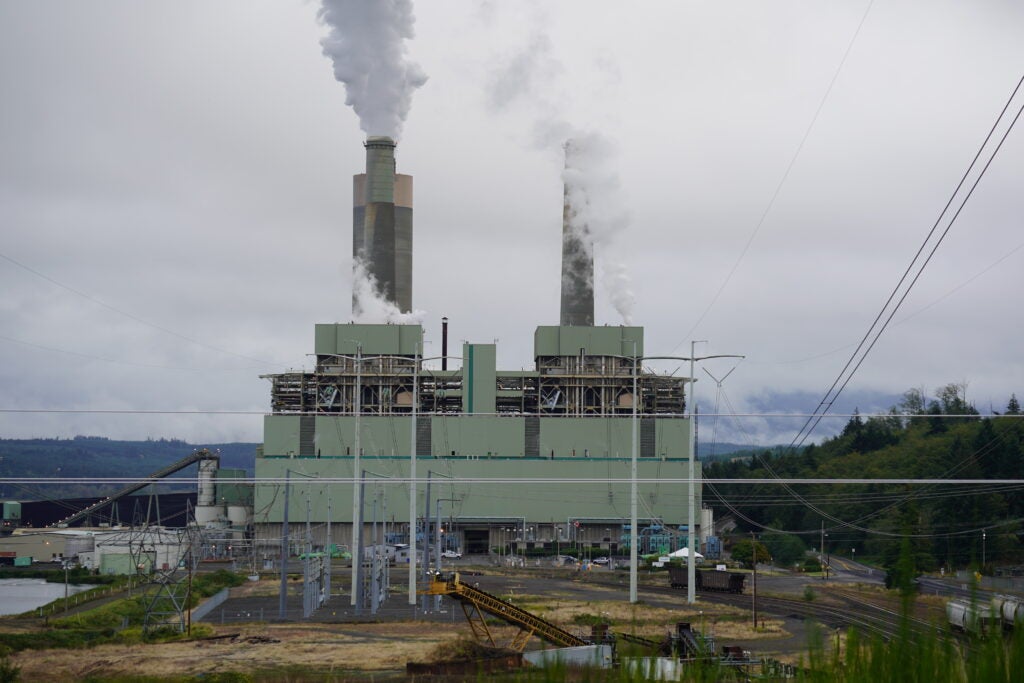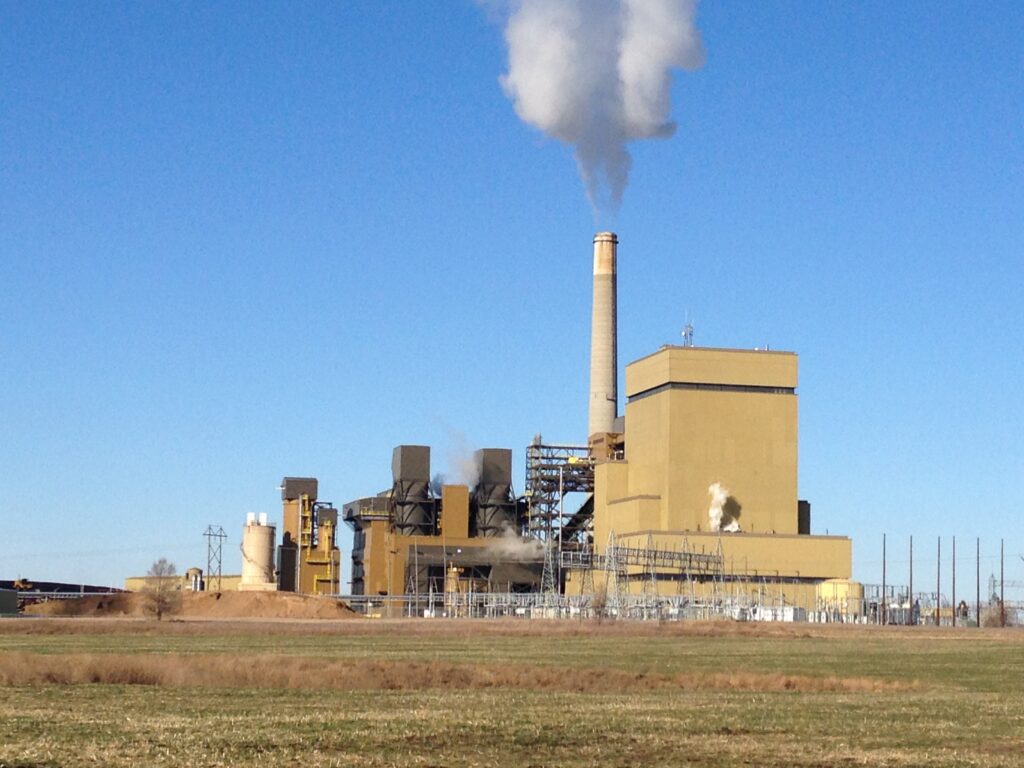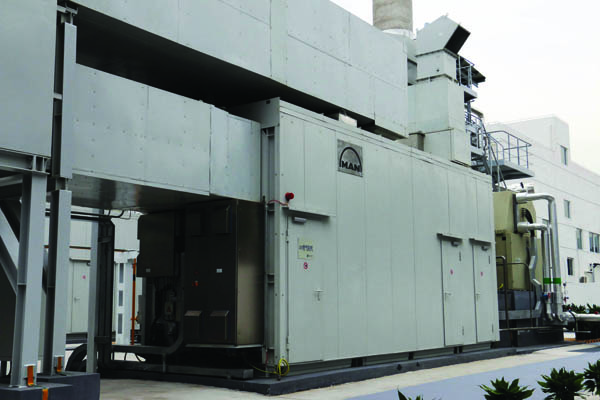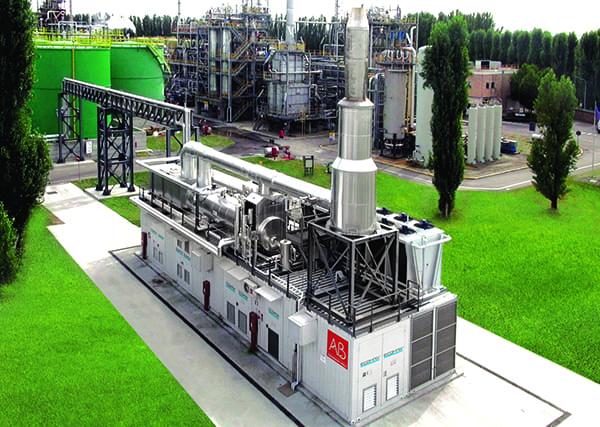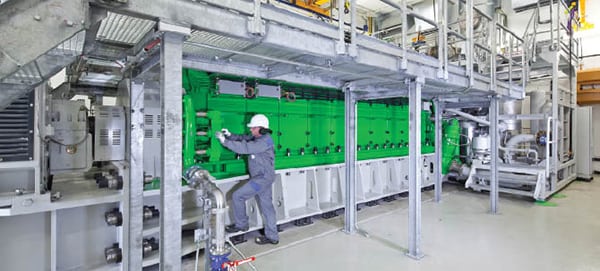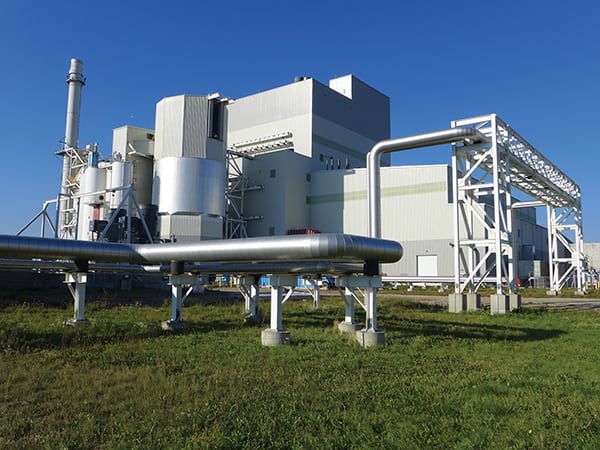
A variety of approaches have been used to capture new benefits from combined heat and power (CHP) facilities. Some owners have transitioned to new fuels or added renewables to the mix, while others have implemented unique business models to spur development. As district heating systems are brought into the 21st century, the CHP sector seems destined for more change.
One of the oldest and least dynamic sources of distributed generation is finally starting to evolve. For more than a century, combined heat and power (CHP) has been a staple of universities, hospitals, and other industrial sites with large energy needs, as well as municipal district heating (DH) systems, but the approaches to generating power and how these systems are developed and paid for have changed relatively little in decades. But now, the economic, environmental, and regulatory pressures that are remaking the power sector at large are also beginning to foster some significant changes with CHP. As large utility-owned power plants are transitioning toward cleaner generation, greater efficiency, and innovative business models, the CHP world is following suit.
A History of Coal Usage
On college campuses, administrators have long recognized the value of CHP plants. Institutions are a natural fit for the solution because their facilities not only have a large demand for electricity but also have massive heating and cooling needs.
CHP offers universities a win-win solution because electricity can be produced from high-pressure steam, while thermal energy can be extracted at appropriate pressures for heating or cooling needs. Efficiency is improved from what is often less than 40% when the services are supplied separately to more than 75%, in some cases, using CHP technology. That not only saves money on energy costs, but it also reduces environmental emissions. And the environmental considerations are frequently a driving factor for change.
That was the case at Michigan State University (MSU). MSU—founded in 1855—sits on a 5,200-acre site in East Lansing, Mich. The campus includes 532 buildings with about 21.7 million square feet of floor space. Near the center of it all rests the Simon CHP plant—the fifth in a long history of MSU power plants. The Simon plant has four dual fuel–capable boilers with a total steam capacity of 1.2 million pounds per hour at 900 psig. Each unit was designed to operate at full power on either coal or natural gas.
The first two units were built in 1965, and a third boiler was added in 1973. That unit was required to burn low-sulfur coal to comply with the Environmental Protection Agency’s (EPA’s) Prevention of Significant Deterioration (PSD) rule. In 1993, a circulating fluidized bed boiler was constructed at the plant, and this fourth unit was the first to include flue gas desulfurization technology. The most recent addition was in 2006 when a 13.5-MW combustion turbine was installed. That unit includes a heat recovery steam generator, which feeds into the plant’s combined steam header. The facility has five steam turbine generators with a total capacity of 85 MW. Each of the turbines has controlled steam extraction to supply thermal loads, as needed.
Bob Ellerhorst, director of Utilities and Waste Management for MSU, explained to POWER in an interview that the Simon plant used coal as its main source of fuel from the outset. Natural gas was simply not economical. But in 2009, the university decided it wanted to transition out of using fossil fuels and into more sustainable energy sources. To do so, it needed a long-range energy transition plan.
Switch to Gas Makes Sense (and Cents)
The school formed an Energy Transition Steering Committee—a 24-member group of students, faculty, and staff—to handle the planning task. The group was to develop a strategy to help MSU reliably meet its future energy needs while managing costs and environmental consequences.
Some students got involved in other ways to help promote change. At the time, a national campaign to end coal use on several university campuses was in progress; MSU students got heavily engaged in that effort.
But economics and regulatory requirements were also changing. The price of natural gas was in a historic decline. In 2010, as prices softened, natural gas began to displace the low-sulfur coal that was being used in the plant’s PSD unit. When the EPA finalized its Boiler Maximum Achievable Control Technology (MACT) rule in January 2013, the decision was easy: Rather than install a $7 million retrofit to comply with the rule and continue burning coal, MSU would make the all-out switch to natural gas. Although plant management’s preference might have been to keep coal capability as an option, the concession was made to completely discontinue its use.
However, the change wasn’t as simple as flipping a switch. Although the dual-fuel boilers were designed to run at full capacity on natural gas, the fuel supply was another matter. Because usage throughout the region had increased since the line was installed, the infrastructure from the local gas distribution company was no longer adequate to operate on 100% gas. For that reason, MSU had to work with Consumers Energy to reestablish 1993 capacity guarantees.
Those changes were paid for by the utility, but MSU had to fork out some money of its own. Inside the plant, the gas supply lines to each boiler had to be modified to more reliably supply gas to the burner front of each unit. The university also paid to have a second gas line installed from the distribution system to the plant for reliability, so it now has a 100% redundant gas supply.
Finally, discontinuing the use of coal required that the conveyance systems, rail tracks, and coal pile be removed. Those grounds have since been remediated and, for all practical purposes, there’s no evidence that coal was previously stored on-site (Figures 1 and 2).
 |
1. Before. This image shows Michigan State University’s (MSU’s) coal yard prior to the coal-to-gas switch. Courtesy: MSU Infrastructure Planning and Facilities |
 |
2. After. This is MSU’s coal yard after the fuel switch. The front two-thirds was seeded, and gravel was placed in the back third. Courtesy: MSU Infrastructure Planning and Facilities |
CHP Goes Renewable (Again)
Other shifts are also afoot, but in ways unique to CHP. CHP plants powered by renewable sources are far from new, and the paper and forestry industries worldwide have long relied on captive biomass plants burning waste materials from their operations, as have sugar refiners (see “Bagasse and Blended Biomass Cogeneration Advances in the Cuban Sugarcane Industry” in the February 2016 issue). In some countries, such as Finland, where forest products are a significant industry, the majority of industrial CHP is fired by biomass. The rationale behind such operations is simple: Where industrial processes create large combustible waste materials, it’s cheaper and more efficient to use those waste materials as fuel than it would be to purchase and transport fuel from elsewhere.
Plants like these continue to be reliable contributors, but there’s also been a recent shift toward renewable CHP outside of those sectors. A number of large coal-fired CHP plants have converted to biomass, particularly in Europe, where aggressive carbon-reduction schemes have disfavored coal.
In December 2016, what was once Denmark’s largest coal plant, the Avedore Power Station in Copenhagen (shown on this issue’s cover and in this article’s header photo), completed a conversion to firing wood pellets. Owned by DONG Energy, the two-unit, 793-MW plant was already firing a variety of fuels in its newer Unit 2. Unit 1, completed in 1990, initially fired coal, but the decision was made in 2013 to convert the entire plant to biomass. The project was overseen by the Ramboll Group, and DONG says Avedore, as a result of supporting Copenhagen’s DH system, can now achieve 89% efficiency. (Unit 2, which fires straw and wood pellets but can also fire natural gas and fuel oil, will convert to pure biomass by 2027.)
The company is pushing ahead with other such conversions. Thomas Dalsgaard, the firm’s executive vice president, said when the Avedore conversion was nearing completion, “Our target is that at least half of the electricity and heat generated at our power stations in 2020 will be based on sustainable biomass instead of coal and gas.” Avedore is in fact the third such coal-to-biomass CHP project DONG has undertaken. The Herning CHP Plant was converted in 2009, while the Studstrup Power Station was converted in 2016, reaching completion shortly before Avedore.
A New Risk Management Process
But making these kinds of shifts in generation is not without risk. Back at MSU, the university was concerned about the potential for price volatility once it began relying solely on natural gas for its energy needs. The cost for coal had always been fairly stable, but the university knew that the price for natural gas was much less predictable. The plan was for MSU to transition from burning 248,320 tons of coal and 0.46 billion cubic feet (Bcf) of natural gas in fiscal year (FY) 2008 to burning 6.5 Bcf of gas and no coal by FY 2017. The price risk was troubling.
“That transition caused us to look for expert buyers in the natural gas industry, and that’s when we connected with U.S. Energy,” Ellerhorst said.
U.S. Energy Services (recently renamed Kinect Energy) helped the university develop a formal, written, price-risk-management plan for purchasing natural gas. The goal of doing so was to build a consensus among all of the stakeholders, so gas procurement decisions could be made based on the school’s price-risk aptitude.
The process included conducting individual surveys with all of the decision-makers to determine their willingness to accept natural gas price risk (Figure 3). To assess risk tolerance, choices were offered, such as buying solely on the cash market or hedging from some to all of the anticipated demand. The team then developed a consensus on the best approach.
 |
3. Price-risk-management matrix. Basing decisions on market approach and risk tolerance gave MSU stakeholders more comfort in their choices. Source: U.S. Energy Services |
“The university has the authorization and the approval to hedge varying percentages by year, out to five years into the future, for budget certainty,” said Bruce Hoffarber, vice president of market development for U.S. Energy Services.
A group, known as the gas operations team, was established with members from plant operations, the school’s budget office, administration, and U.S. Energy. The team meets quarterly to review market changes and, if necessary, establish new triggers.
“The four heads try to come up with the best answers based on the risk strategy that was laid out for us,” Ellerhorst, who represents the operating component, said.
Although the process has been a learning experience, the results have been encouraging. Ellerhorst said MSU is about 95% hedged for the 2016–2017 winter, which will insulate the university from recently forecast price increases. Hoffarber suggested that the average hedge price was beating the market, even though that is not the goal. In the end, having a structured and disciplined approach to layering hedges provides budget certainty and reduces risk over the long term.
“In our next meeting with U.S. Energy, we’ll be talking about the un-bought pieces for fiscal year 2018 and 2019,” Ellerhorst said. “What’s the wisdom? What do we do?” Those are questions they’ll help answer.
Partnering on CHP Projects
While MSU owns and operates its own CHP plant, Duke University has taken a different approach to CHP. In a university-published overview of a proposed project, the school said, “The regulated-monopoly framework on which North Carolina allows utility companies to operate makes self-ownership unattractive.” Therefore, it proposed leasing an acre of land to Duke Energy—the campus’s current electric service provider—for 35 years, which would allow the company to build, own, and operate an on-site natural gas–fired CHP plant.
Duke Energy chose Burns & McDonnell as the engineer of record for the proposed plant (Figure 4), which is expected to include a 21-MW combustion turbine generator and a heat recovery steam generator capable of producing about 75,000 pounds per hour of steam for the university. The CHP facility would be connected to an existing Duke Energy substation located on the campus.
Duke Energy said the $55 million project would lower energy-related CO2 emissions at Duke University by about 25% “by displacing the current electricity mix and boilers currently serving the university.” The proposed project would be designed with an island-mode feature, allowing critical campus loads to be isolated from the grid and powered by the plant during crises.
Students Raise Concerns
But just as students at MSU took a stand against coal, some students at Duke University have objected to the planned CHP plant. According to a story published by The Chronicle, the university’s student-run newspaper, there seem to be two main concerns about the project: The lack of transparency leading up to the proposal’s announcement and the continued use of fossil fuels to power the campus.
Duke University President Richard Brodhead responded to students’ apprehensions about the project in a letter to The Chronicle. In it, he said the university was pursuing the project for “energy reliability and security.” He pointed out that the medical center and research center “must have a continuous source of electricity that is impervious to weather events and other emergencies that can cause widespread and lengthy power outages.”
Beyond the plant’s dependability, Brodhead underscored the improved efficiency that CHP plants provide, and he noted that the technology “has always been a component of the university’s Climate Action Plan, which calls for carbon neutrality by 2024.” To ease fossil fuel concerns, Brodhead suggested that renewable fuel sources would eventually replace natural gas at the facility.
“We are continuing to discuss the plant using bio-gas when it becomes commercially available, as well as the commitment that the university and Duke Energy would make to help that occur,” he wrote.
As this story goes into production in late December, the project still requires approval by the North Carolina Utilities Commission (NCUC). Although “very optimistic” about the prospects, Duke Energy filed a request with the NCUC on December 1 to suspend the discovery and procedural dates until after May 2017 to allow time for the university to work with stakeholders regarding the role of CHP in the school’s broader sustainability goals.
The Duke University CHP plant is a first-of-a-kind project on the Duke Energy Carolinas system. However, in its application with the NCUC, Duke Energy noted that it has been soliciting interest in CHP from large industrial, institutional, and military customers since 2015. The company claims that there are several interested parties, and it suggested that experience from the Duke University project would benefit all of its future CHP ventures.
Community and Containerized CHP
Compared to university projects like MSU’s and Duke’s, large-scale renewable CHP projects are usually driven by policy rather than economics. But in recent years, there’s been more attention paid to smaller plants that are designed from the start to provide renewable energy for its own sake—and these projects are typically set up for economic reasons, allowing their owners to capture energy and heat from waste streams that would otherwise be lost.
Anne Hampson, project manager with ICF, told POWER in an interview that much of the growth in renewable CHP is being driven by improvements in technology and standardization that have substantially reduced the cost of generation. “With some of the CHP systems that are available in the market, they can really reduce the capital expenses for these smaller sites because they are prepackaged,” she said. “A lot of them are built into shipping containers so the engine and heat recovery is all combined. It’s really bringing the cost of those installations down and opening up a whole new market.”
ICF estimates that about 4,500 MW of renewable-powered CHP is in operation across the U.S., Hampson said. This includes traditional large-scale biomass but also an increasing amount of small-scale generation. One trend Hampson has seen might be dubbed “community CHP.” Much as groups of homeowners and businesses have combined resources to install centralized solar (see “Solar Gardens: A Fast-Growing Approach to Photovoltaic Power” in the May 2015 issue), farms and ranches in a growing number of areas are working together to build anaerobic digester systems that serve the surrounding community and use the produced biogas to generate heat and power.
“In the past, you saw these mostly in California and the Northeast, but lately we’re seeing a lot more traction in the Midwest and even parts of the South.” Again, the primary driver is the falling cost of “plug-and-play” CHP systems, which make small-scale biomass and biogas streams economic to exploit where they once were not.
One company offering these containerized CHP solutions is 2G Energy, which is based in Germany but which has supplied systems across the U.S. and Canada, mostly in the 500-kW to 2-MW range. It recently built a 1,200-kW system at a large duck farm in Middlebury, Ind. (Figure 5). The farm operates an anaerobic digester using animal waste and processing plant by-products, as well as corn silage and other substrates. The three 2G agenitor 212 generators run on biogas from the digester. Those generators supply power that is sold to the local utility and heat process water that is used on-site at the farm and processing plant.
The options for this kind of “plug-and-play” CHP are growing rapidly. Other companies such as Dresser-Rand and Czech firm Tedom are also offering turnkey, containerized CHP systems in the hundreds-of-kilowatts range. Most of these are engine-based systems, but Hampson said microturbines are seeing increasing use because of their efficiency. For locations with access to solid fuel, such as wood waste rather than biogas, there are also solutions available. Entrade and Spanner Re2 manufacture systems in tens-of-kilowatt capacities that gasify and combust wood pellets or chips to produce heat and power.
Another growth area is wastewater treatment plants, which Hampson said accounted for the largest share of new CHP installations by type of facility that ICF saw in 2015. “It’s been a major source of new capacity,” she said. These projects are growing not just in number but in size as well: The Marselisborg Wastewater Treatment Plant in Aarhus, Denmark, recently installed a biogas-powered CHP system that not only makes the plant fully self-powering but also allows it to supply excess power and heat to the local grid and DH network (see the item in this month’s Global Monitor).
Yet another trend is the use of landfill gas (LFG). LFG has long been captured and exploited for power on site, but recently, developers of institutional CHP projects have looked at building pipelines to carry LFG to their facilities, rather than relying on their utility’s natural gas hookup. (One example is the Duke University project, which hopes to eventually transition to biogas.)
District Heat: Everything Old Is New
DH and CHP have long gone hand-in-hand, with DH systems often set up to take steam from a thermal plant supplying power to the same area. Systems like these have often been operating for many decades—there are DH networks in the eastern and northeastern U.S. that are more than 100 years old. Natural gas–fired DH has drawn renewed interest in recent years because of efficiency and environmental advantages offered over fuel oil (not to mention the cost advantages as gas prices have fallen), but making the best use of these aging systems can require some substantial upgrades.
One such project was recently completed by Veolia at the Kendall Cogeneration Station in Cambridge, Mass. (Figure 6). [Ed. correction made 4/24/2017. The Figure 6 image was changed because the original photo was of the Massachusetts Institute of Technology plant rather than of the Kendall plant.] The 256-MW, 7FA-based plant has supplied power to the surrounding area since 1949, and it currently supplies DH services to more than 250 medical research institutions, hospitals, hotels, museums, and government buildings throughout Boston and Cambridge. But for many years, it was underutilized: The plant was capable of supplying substantially more steam than the DH system used. There was also another problem, an issue that wasn’t recognized when the plant was built but that began drawing attention in the 1990s. The plant’s use of cooling water from the Charles River was having an impact on the aquatic ecosystem, as the warmer temperatures caused by the cooling effluent were contributing to toxic algae blooms. As a result, environmental groups and the EPA began pressuring the plant’s owners to phase out its original once-through cooling (OTC) system.
Veolia acquired the DH system in 2005 and began looking at an upgrade and expansion project that would fully leverage Kendall’s capacity while making the overall system more efficient and environmentally friendly. The first step was running a second steam pipeline from Kendall (which was then owned by GenOn) to Veolia’s DH system. That 7,000-foot extension, which came online in 2013, doubled the amount of steam it was able to take from Kendall. With the upgrade, Veolia’s 26-mile-long DH network now gets 75% of its steam from the plant, reducing reliance on smaller on-site boilers and increasing overall efficiency.
When Veolia and its partner, I Squared Capital, acquired Kendall in 2014, the second phase began. That $112 million project, completed in October 2016, replaced the old OTC system with a new air-cooled condenser. Together, the upgrades have reduced both air pollution in the surrounding area and thermal pollution in the river.
Boston is not the only eastern city to look at upgrades to its DH system. Pittsburgh is also in the midst of a multi-faceted project to improve the efficiency and carbon footprint of its downtown DH system, which is actually two different networks in and around the city center. NRG operates one of them, and it has been tasked by the city with building a third. The planned Uptown EcoInnovation District will employ a modern steam plant powered by Cleaver-Brooks boilers and serve several major customers, including the Consol Energy Center and the UPMC Mercy medical center. The $61 million project received approval from the city council in September 2016 and is only one of four new energy districts the city is looking at developing. NRG is also looking at adding a new combined cycle CHP plant to the DH network it operates and helping develop a series of CHP microgrids. ■
—Aaron Larson and Thomas W. Overton, JD are POWER associate editors.



